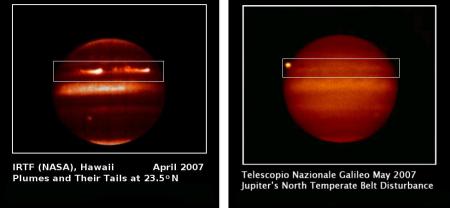NICS-TNG data contribute to the analysis of an unusual atmospheric perturbation on Jupiter
In March 2007 Jupiter surprised the scientific community with a violent change in its atmosphere. A giant turbulence triggered two extended storms in the Northern hemisphere of the planet. The unusual phenomenon was studied by an international team of scientists, including astronomers of the Telescopio Nazionale Galileo (TNG). They suggest the internal energy of Jupiter is the main responsible for the formation of the storms.In the issue of January 24th, Nature dedicates its cover to this research. In a letter published in the same issue of this magazine, the scientists claim that the storms injected a mixture of ammonia and water ice in the higher layers of Jupiter atmosphere. The atmospheric perturbations reached a speed of 600 km/h (the highest wind velocity in Jupiter "jet" streams) but, surprisingly, did not alter the nature of the jets. Afterwards, a trail of red turbulent clouds surrounded the giant planet forming a new atmospheric belt.
The scientific team followed the evolution of the phenomenon both from the space and from the Earth using the Hubble Space Telescope and a battery of ground-based telescopes. The data obtained in the near-infrared with NICS-TNG helped the scientists to measure the temperature, the height and the extension of this rare meteorological event.
(A. Sanchez-Lavega, et al., "Depth of a strong jovian jet from a planetary-scale disturbance driven by storms", 2008, Nature, vol. 451, pages 437-440)

Two near-infrared images of Jupiter taken in April (left; from Hawaii) and May (right; NICS-TNG image) 2007. In April the storms reached a high level of activity; in May they disappeared and a new red and much fainter belt surrounded the planet.

